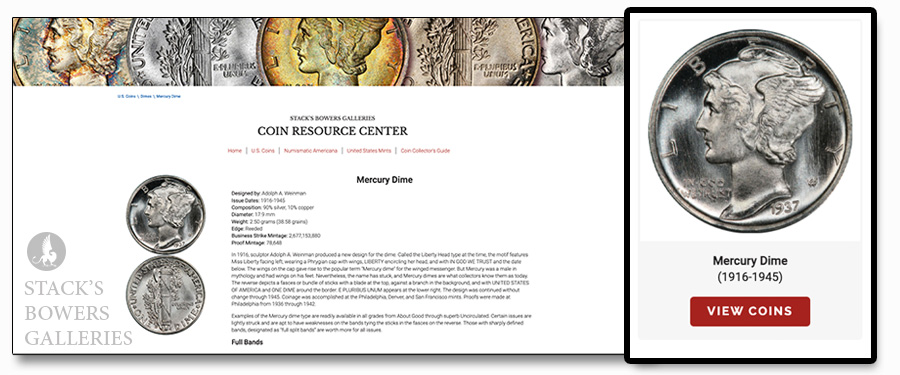
Though the Stack’s Bowers Galleries Coin Resource Center is not yet complete, it does have detailed entries on every U.S. coin series. Even without the full complement of dates, interested collectors can still glean valuable information about any series, Today we’ll be focusing on the Winged Liberty Head dime, a popular and generally affordable type coin regarded as one of the United States’ more attractive coins. The CRC will serve as a helpful primer to those approaching the series for the first time.
Adolph Weinman’s Winged Liberty Head motif debuted in 1916, inaugurated alongside new, classically-inspired designs for the quarter and half dollar. All three designs were part of the Renaissance of American Coinage, a program to beautify U.S. coins launched by the Roosevelt Administration in the first decade of the 20th century. Liberty’s winged cap, representing freedom of thought, inspired the “Mercury” nickname, with many observers likening it to the winged helmet of the Roman messenger and merchant god.
Like its higher-denomination counterparts, strike quality proved a perennial issue for the Winged Liberty Head dime. Its characteristic area of weakness is the fasces (the bundle of wooden rods bound together with an ax, a classical symbol of sovereign power and root of the word “fascism”) and olive branch on the reverse. One important barometer for gauging strike quality is the sharpness of the central set of bands binding the rods. Coins with “Full Bands” command a premium, which is in some cases significant. The series’ final Philadelphia Mint issue, the 1945, has a retail value of roughly $45 in MS-65 (per PCGS CoinFacts); adding the Full Bands designation makes the coin worth about $21,000.
Our CRC entry describes Full Bands as follows: “The center horizontal crossband binding the sticks of the fasces on the reverse of the Mercury dime is actually two separate bands. In an effort to prolong die life, mint workers would sometimes slightly increase the spacing between the dies, which resulted in the failure of these center bands to completely strike up. During the 1970s, collectors of Mercury dimes began to show a preference for fully-struck or ‘split band’ dimes, and premiums for these pieces increased. When the third-party grading services began operations in the mid-to-late 1980s, ‘FB’ or Full Bands were immediately recognized.
“If any part of the dividing line between the bands is merged, however small, the coin will not qualify. The line must be complete and unbroken.” Photos of coins exhibiting and lacking Full Bands are included with the listing. CRC listings will include similar discussions of grading designations relevant to values of coins in different series – i.e. Full Head for Standing Liberty quarters or Full Steps for Jefferson nickels.





